The arid garden might be short on colorful fall foliage, but that doesn’t mean you need to resign yourself to a colorless fall landscape. There are many beautiful plants that celebrate the coming of autumn by bursting forth with flowers of all colors.
Here are 10 favorite fall-flowering plants that will add colorful beauty to your outdoor space. All are drought-tolerant and relatively fuss-free. Most need pruning no more than once a year. The only thing missing will be the raking up of fallen leaves.
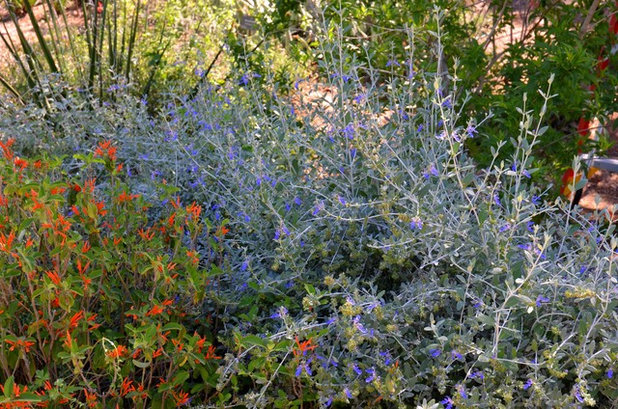
Noelle Johnson Landscape Consulting
Shown: Mexican honeysuckle
(
Justicia spicigera) and
‘Azureum’ bush germander (
Teucrium fruticans ‘Azureum’), two fall-blooming drought-tolerant plants.
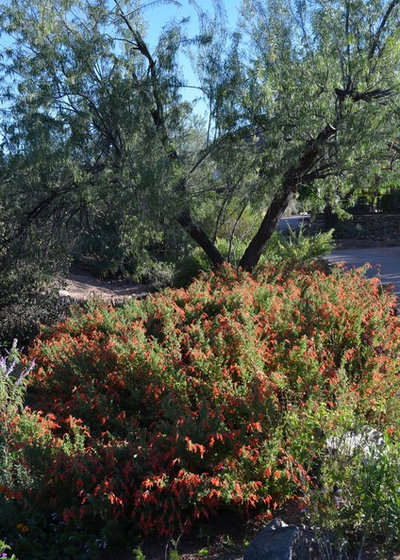
Noelle Johnson Landscape Consulting
California Fuchsia(
Zauschneria californica, syn.
Epilobium canum)
Native to the Western U.S. and northern Mexico
Who says fall’s red color can only be found on trees? Western native California fuchsia produces generous amounts of orange-red flowers that are irresistible to hummingbirds. Flowering begins in summer and lasts into fall.
Where it will grow: Hardy to 10 degrees Fahrenheit (minus 12 degrees Celsius), zones 8 to 10 (find your zone)
Water requirement: Low; water deeply, to 2 feet, twice a month in summer, every three weeks in spring and fall and monthly in winter
Light requirement: Full sun (filtered shade in the low desert)
Mature size: 3 to 4 feet tall and 4 to 5 feet wide
Growing tips: Plant in well-drained soil; prune back to the ground in late fall to rejuvenate once established
See how to grow California fuchsia
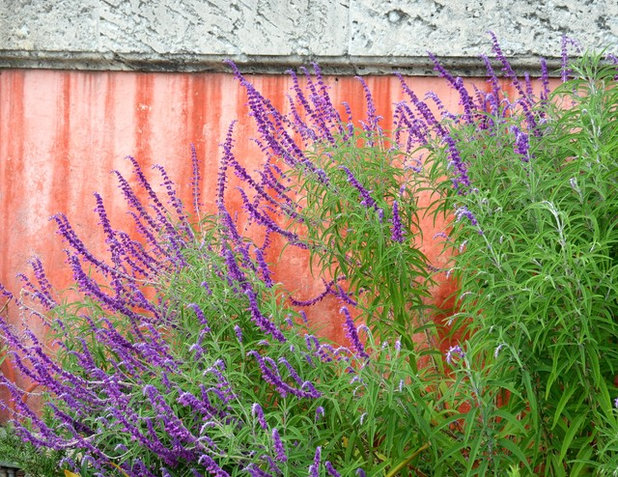
Noelle Johnson Landscape Consulting
Mexican Bush Sage(
Salvia leucantha)
Native to central and eastern Mexico
Both butterflies and hummingbirds frequently visit the attractive, fuzzy purple spikes this popular salvia produces. Blooms appear in spring and again in fall. In areas with mild summers, flowering can continue throughout those months. In colder climates, it’s sometimes grown as an annual.
Where it will grow: Hardy to 20 degrees Fahrenheit (minus 7 degrees Celsius), zones 9 to 10
Water requirement: Low; water weekly in summer, every two weeks in spring and fall and every three weeks in winter
Light requirement: Filtered shade is best
Mature size: 4 feet tall and 5 feet wide
Growing tips: Plant in well-drained soil; plants will die back to the ground when temperatures dip into the low 20s; prune back to the ground in early spring, after the last frost date for your area; lightly prune in late summer if needed to control sprawling growth
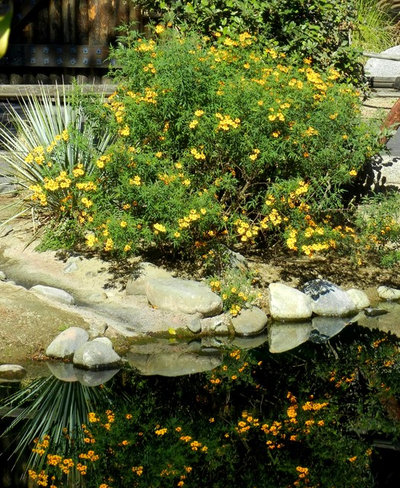
Noelle Johnson Landscape Consulting
Lemmon’s Marigold(
Tagetes lemmonii)
Native to Mexico
Finely textured, aromatic leaves cover Lemmon’s marigold (also called copper canyon daisy) throughout the year. Bright-yellow, daisy-like flowers appear throughout winter, spring and fall, taking a break in summer. Deer steer clear of this attractive shrub, making it a great choice for gardens with deer roaming nearby.
Where it will grow: Hardy to 0 degrees Fahrenheit (minus 18 degrees Celsius), zones 7 to 10
Water requirement: Low to moderate; water weekly in summer (every four to five days in low-desert gardens); monthly watering in winter is sufficient
Light requirement: Full sun or filtered shade
Mature size: 4 feet tall and wide
Growing tips. Plant in well-drained soil in a hole enriched with compost; fertilize once a year in spring; prune back to 1 foot tall and wide in early spring
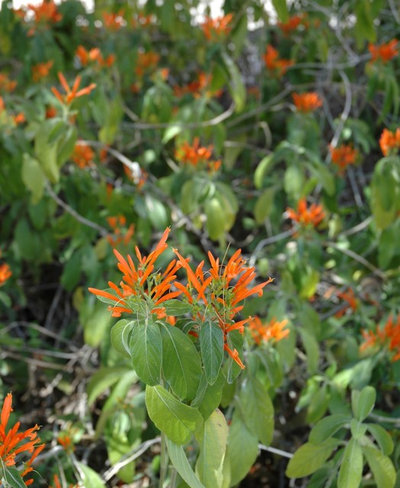
Noelle Johnson Landscape Consulting
Mexican Honeysuckle(
Justicia spicigera)
Native to Mexico and South America
The orange, tubular flowers of this small shrub appear not just in fall, but all year long. Light green leaves add a tropical feel to the garden, and its flowers attract hummingbirds, making Mexican honeysuckle a must-have for gardens where hummingbirds live year-round.
Where it will grow: Hardy to 10 degrees Fahrenheit (minus 12 degrees Celsius), zones 8 to 10
Water requirement: Low to moderate; water weekly in summer and every two weeks throughout the rest of the year
Light requirement: Filtered sun
Mature size: 3 to 4 feet tall and wide
Growing tips: Plant in well-drained soil amended with compost; prune in early spring to desired size
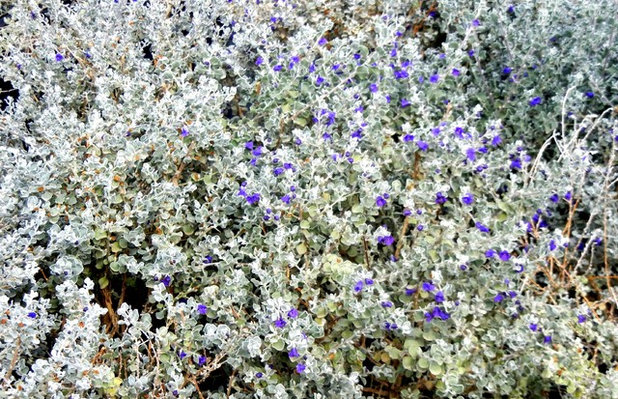
Noelle Johnson Landscape Consulting
Violet Silverleaf(
Leucophyllum candidum)
Native to southwestern Texas and Mexico
Violet silverleaf’s silvery- gray foliage catches your attention at first glance — until it begins to bloom, when it produces vibrant purple flowers that quickly take center stage. Flowering occurs in spurts, often in response to increased humidity. Blooming begins in summer and increases in the fall.
Where it will grow: Hardy to 0 degrees Fahrenheit (minus 18 degrees Celsius), zones 7 to 10
Water requirement: Low; water twice a month in summer and monthly in winter
Light requirement: Full sun
Mature size: 3 feet tall and 3 to 4 feet wide
Growing tips: Plant in well-drained soil and full sun; over-watering will lead to rot, so sporadic, deep watering is best; little to no pruning is needed other than to hand prune any wayward branches when given enough room to grow to its mature size
See how to grow two garden varieties of violet silverleaf
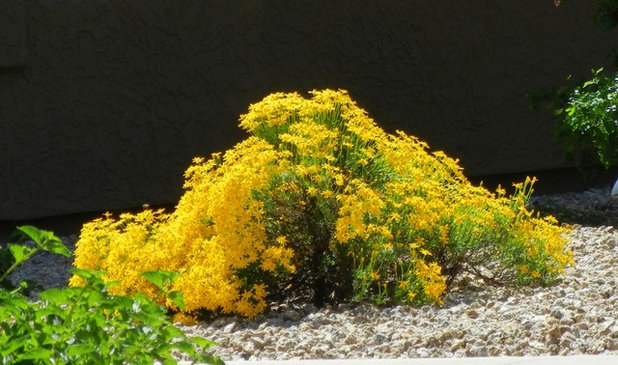
Noelle Johnson Landscape Consulting
Damianita(
Chrysactinia mexicana)
Native to arid regions of the American Southwest
Drought-tolerant Damianita covers the ground in a carpet of yellow in both spring and fall, with occasional spurts in summer. Tiny, aromatic, needle-like leaves have an attractive dark green color. When used along pathways or grouped together next to boulders, they are sure to impress with their stunning color display.
Where it will grow: Hardy to minus 10 degrees Fahrenheit (minus 23 degrees Celsius), zones 6 to 10
Water requirement: Low; water weekly in summer, every two weeks in spring and fall and monthly in winter
Light requirement: Full sun
Mature size: 2 feet tall and wide
Growing tips: Plant in well-drained soil; lightly shear in late spring and fall to promote additional blooms
See how to grow damianita
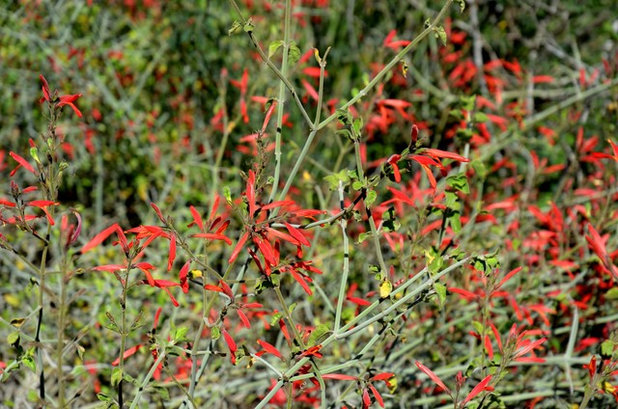
Noelle Johnson Landscape Consulting
Chuparosa(
Justicia californica)
Native to the Sonoran Desert of North America
Vibrant orange-red flowers appear throughout the year, providing a valuable source of color to the drought-tolerant garden. The sprawling chuparosa is at home in a natural-style landscape. Heart-shaped leaves may or may not be present on the stems, depending on water availability. As you might expect from its red, tubular flowers, it’s a hummingbird favorite and provides much-needed nectar in the winter months when not much else is blooming.
Where it will grow: Hardy to 20 degrees Fahrenheit (minus 7 degrees Celsius), zones 9 to 10
Water requirement: Low; water one to two times a month in summer and twice a month in winter, when much of the flowering occurs
Light requirement: Full sun and filtered shade
Mature size: 3 to 4 feet tall and 4 to 5 feet wide
Growing tips: Plant in well-drained soil; little to no pruning is required other than to remove frost-damaged growth in late spring after most of the spring bloom has faded; avoid any heavy pruning
See how to grow chuparosa
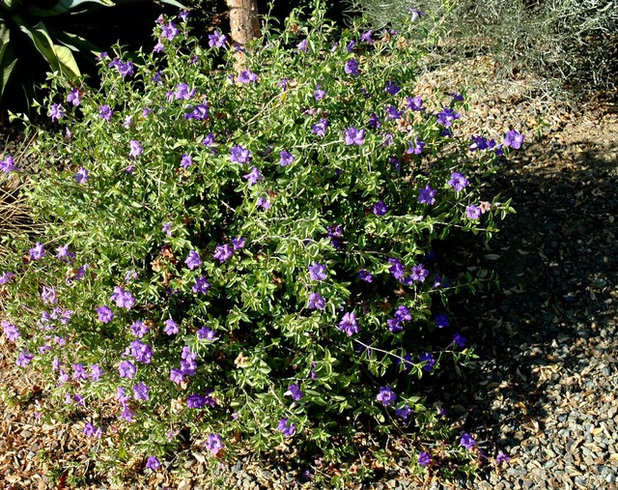
Noelle Johnson Landscape Consulting
Desert Ruellia(
Ruellia peninsularis)
Native to Baja California, Mexico, and the Sonoran Desert
Purple blossoms decorate the white stems and bright green leaves of this desert native. Desert ruellia is often used as a smaller alternative to Texas ranger (
Leucophyllum frutescens). Flowers appear year-round, slowing down in winter. It’s slightly more cold-sensitive than Texas ranger and has hairy leaves. Unlike Mexican petunia
(Ruellia brittoniana), desert ruellia does not readily spread or self-seed.
Where it will grow: Hardy to 20 degrees Fahrenheit (minus 7 degrees Celsius), zones 9 to 10
Water requirement: Low; water twice a month in summer, every three weeks in spring and fall and monthly in winter
Light requirement: Full sun is best for maintaining a compact shape, but it will grow in filtered sun
Mature size: 3 to 4 feet tall and wide
Growing tips: Plant in well-drained soil; if allowed enough room to grow, pruning once a year is all that’s needed; prune back to 1½ feet tall and wide in spring; no other pruning is needed
See how to grow desert ruellia
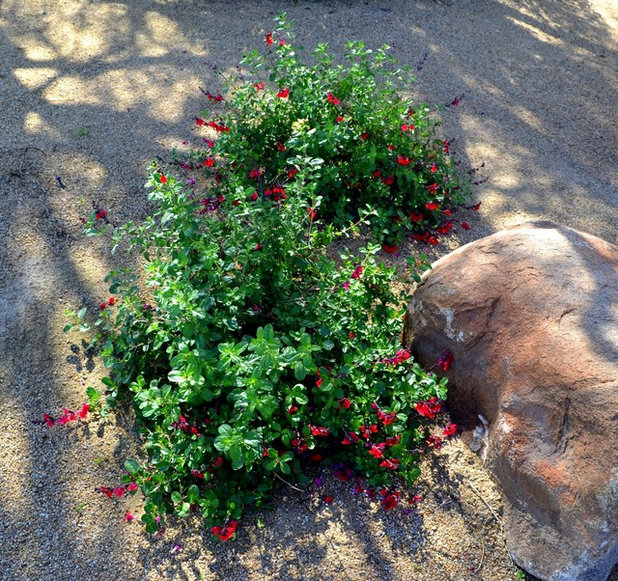
Noelle Johnson Landscape Consulting
Autumn Sage(
Salvia greggii)
Native to Texas, New Mexico and Mexico
Petite autumn sage packs a punch in the landscape with its profusion of flowers that appear in spring and fall. The blooms can continue through mild summers and winters as well. The plants’ relatively small size makes them a great choice for smaller areas, whether scattered throughout the landscape or clustered together. Hummingbirds will be flitting about enjoying the nectar from the flowers.
Where it will grow: Hardy to 0 degrees Fahrenheit (minus 18 degrees Celsius), zones 7 to 10
Water requirement: Low to moderate; water every five to seven days in summer, weekly in spring and fall and twice a month in winter
Light requirement: Plant in filtered sun, especially in hot desert climates
Mature size: 3 feet tall and wide
Growing tips: Plant in well-drained soil; prune back to half their size in early spring; apply fertilizer in late spring
See how to grow autumn sage
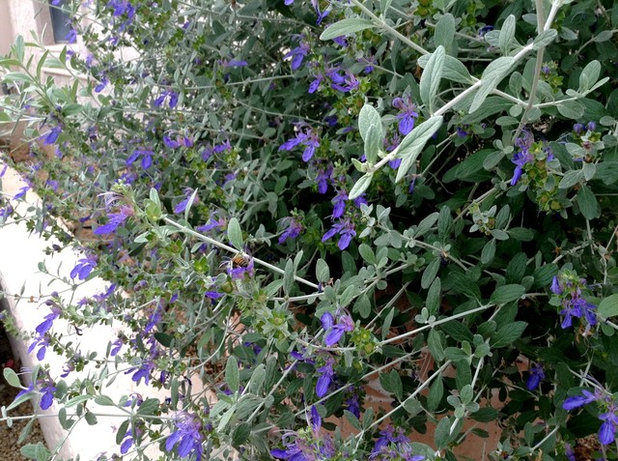
Noelle Johnson Landscape Consulting
‘Azureum’ Bush Germander(
Teucrium fruticans ‘Azureum’)
Native to the Mediterranean region
The attractive silvery foliage and blue flowers of bush germander, also called shrubby germander, add a visually cooling element to the fall landscape. Their blooms first appear in spring and will continue through fall. Highlight its foliage by planting it alongside plants with deeper green leaves for great color contrast.
Where it will grow: Hardy to 20 degrees Fahrenheit (minus 7 degrees Celsius), zones 9 to 10
Water requirement: Low to moderate; water every five to seven days in summer, weekly in spring and fall and twice a month in winter
Light requirement: Full sun
Mature size: 4 feet tall and 5 feet wide
Growing tips: Plant in well-drained soil; prune in early spring to desired shape
More Brilliant Scenes of Fall Color Indoors and Out
More guides to fall gardening





